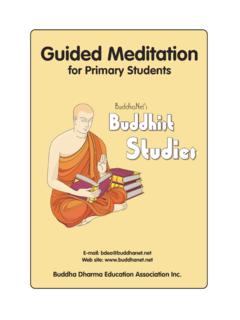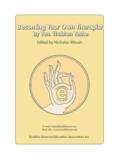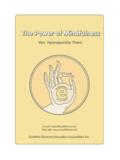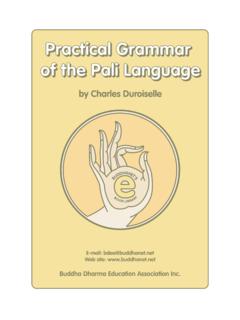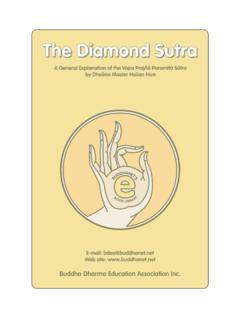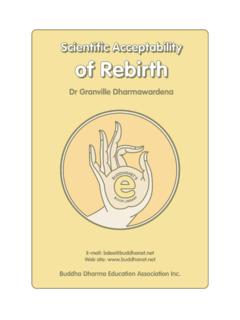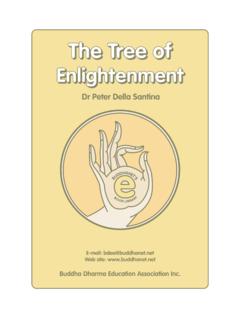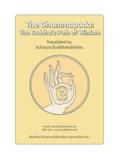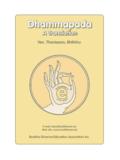Transcription of The Four Noble Truths - BuddhaNet - Worldwide …
1 EBUDDHANET'SBOOKLIBRARYE-mail: site: Dharma Education Association Ajahn SumedhoThe four Noble TruthsThe four Noble Truths3 THE four Noble TRUTHSBy Ajahn Sumedho** ** **THE four Noble Truths is composed of extractsfrom various talks given by Ajahn Sumedho and isavailable in book form from:AMARAVATI PUBLICATIONSA maravati Buddhist CentreGreat GaddesdenHemel HempsteadHertfordshire HP1 3 BZENGLANDwho retains copyright. Amaravati is Ajahn Sumedho smonastery and welcomes visitors; retreats are held thereand several other books by Ajahn Sumedho areavailable. Please send SAE for details.** ** **4 ContentsPreface 5 Introduction 6 The First Noble truth 12 Suffering and self view 14 Denial of suffering 16 Morality and compassion 17To investigate suffering 18 Pleasure and displeasure 20 Insight in situations 23 The Second Noble truth 27 Three kinds of desire 28 Grasping is suffering 30 Letting go 31 Accomplishment 34 The Third Noble truth 36 The truth of impermanence 38 Mortality and cessation 40 Allowing things to arise 41 Realisation 45 The Fourth Noble truth 48 Right Understanding 50 Right Aspiration 56 Right Speech,Right Action.
2 Right Livelihood 57 Right Effort, Right Mindfulness,Right Concentration 60 Aspects of meditation 60 Rationality and emotion 62 Things as they are 64 Harmony 66 The Eightfold Path asA reflective teaching 69 Glossary 704A handful OF LEAVESThe Blessed One was once living at Kosambi in a wood of simsapatrees. He picked up a few leaves in his hand, and he asked thebhikkhus, How do you conceive this, bhikkhus, which is more, thefew leaves that I have picked up in my hand or those on the trees inthe wood? The leaves that the Blessed One has picked up in his hand are few,Lord; those in the wood are far more. So too, bhikkhus, the things that I have known by direct knowledgeare more; the things that I have told you are only a few. Why have Inot told them? Because they bring no benefit, no advancement in theHoly Life, and because they do not lead to dispassion, to fading, toceasing, to stilling, to direct knowledge, to enlightenment, toNibbana.
3 That is why I have not told them. And what have I toldyou? This is suffering; this is the origin of suffering; this is thecessation of suffering; this is the way leading to the cessation ofsuffering. That is what I have told you. Why have I told it? Becauseit brings benefit, and advancement in the Holy Life, and because itleads to dispassion, to fading, to ceasing, to stilling, to directknowledge, to enlightenment, to Nibbana. So bhikkhus, let your taskbe this: This is suffering; this is the origin of suffering; this is thecessation of suffering; this is the way leading to the cessation ofsuffering. [Samyutta Nikaya, LVI, 31]** ** **5 PREFACEThis small booklet was compiled and edited from talks givenby Venerable Ajahn Sumedho on the central teaching of theBuddha: that the unhappiness of humanity can be overcomethrough spiritual teaching is conveyed through the Buddha s four NobleTruths, first expounded in 528 BC in the Deer Park at Sarnathnear Varanasi and kept alive in the Buddhist world ever Ajahn Sumedho is a bhikkhu (mendicant monk) ofthe Theravada tradition of Buddhism.
4 He was ordained inThailand in 1966 and trained there for ten years. He iscurrently the Abbot of Amaravati Buddhist Centre as well asteacher and spiritual guide to many bhikkhus, Buddhist nunsand lay booklet has been made available through the voluntaryefforts of many people for the welfare of on the Text:The first exposition of the four Noble Truths was a discourse(sutta) called Dhammacakkappavattana Sutta literally, thediscourse that sets the vehicle of the teaching in motion. Extracts from this are quoted at the beginning of each chapterdescribing the four Truths . The reference quoted is to thesection in the books of the scriptures where this discourse canbe found. However, the theme of the four Noble Truthsrecurs many times, for example in the quotation that appearsat the beginning of the Introduction.** ** **6 INTRODUCTIONThat both I and you have had to travel and trudge throughthis long round is owing to our not discovering, not penetratingthe four Truths .
5 What four ?They are: The Noble truth of Suffering, The Noble truth of theOrigin of Suffering, The Noble truth of the Cessation of Suffering,and the Noble truth of the Way Leading to the Cessation ofSuffering.[Digha Nikaya, Sutta 16]The Dhammacakkappavattana Sutta, the Buddha s teachingon the four Noble Truths , has been the main reference that Ihave used for my practice over the years. It is the teaching weused in our monastery in Thailand. The Theravada school ofBuddhism regards this sutta as the quintessence of theteaching of the Buddha. This one sutta contains all that isnecessary for understanding Dhamma and for the Dhammacakkappavattana Sutta is considered tobe the first sermon the Buddha gave after his enlightenment, Isometimes like to think that he gave his first sermon when hemet an ascetic on the way to Varanasi. After hisenlightenment in Bodh Gaya, the Buddha thought: This issuch a subtle teaching.
6 I cannot possibly convey in wordswhat I have discovered so I will not teach. I will just sit underthe Bodhi tree for the rest of my life. For me this is a very tempting idea, just to go off and livealone and not have to deal with the problems of , while the Buddha was thinking this way, BrahmaSahampati, the creator deity in Hinduism, came to theBuddha and convinced him that he should go and Sahampati persuaded the Buddha that there were7beings who would understand, beings who had only a littledust in their eyes. So the Buddha s teaching was aimedtoward those with only a little dust in their eyes I m surehe did not think it would become a mass, popular Brahma Sahampati s visit, the Buddha was on his wayfrom Bodh Gaya to Varanasi when he met an ascetic whowas impressed by his radiant appearance. The ascetic said, What is it that you have discovered? and the Buddharesponded: I am the perfectly enlightened one, the Arahant,the Buddha.
7 I like to consider this his first sermon. It was a failure becausethe man listening thought the Buddha had been practising toohard and was overestimating himself. If somebody said thosewords to us, I m sure we would react similarly. What wouldyou do if I said, I am the perfectly enlightened one ?Actually, the Buddha s statement was a very accurate, preciseteaching. It is the perfect teaching, but people cannotunderstand it. They tend to misunderstand and to think itcomes from an ego because people are always interpretingeverything from their egos. I am the perfectly enlightenedone may sound like an egotistical statement, but isn t itreally purely transcendent? That statement: I am theBuddha, the perfectly enlightened one is interesting tocontemplate because it connects the use of I am withsuperlative attainments or realisations. In any case, the resultof the Buddha s first teaching was that the listener could notunderstand it and walked away.
8 ** ** **Later, the Buddha met his five former companions in theDeer Park in Varanasi. All five were very sincerely dedicatedto strict asceticism. They had been disillusioned with theBuddha earlier because they thought he had become insincerein his practice. This was because the Buddha, before he was8enlightened, had begun to realise that strict asceticism was inno way conducive towards an enlightened state so he was nolonger practising in that way. These five friends thought hewas taking it easy: maybe they saw him eating milk rice,which would perhaps be comparable to eating ice cream thesedays. If you are an ascetic and you see a monk eating icecream, you might lose your faith in him because you thinkthat monks should be eating nettle soup. If you really lovedasceticism and you saw me eating a dish of ice cream, youwould have no faith in Ajahn Sumedho anymore. That is theway the human mind works; we tend to admire impressivefeats of self-torture and denial.
9 When they lose faith in him,these five friends or disciples left the Buddha which gavehim the chance to sit under the Bodhi tree and be , when they met the Buddha again in the Deer Park inVaranasi, the five thought at first, We know what he s s just not bother about him. But as he came near, they allfelt that there was something special about him. They stoodup to make a place for him to sit down and he delivered hissermon on the four Noble time, instead of saying I am the enlightened one , hesaid: There is suffering. There is the origin of is the cessation of suffering. There is the path out ofsuffering. Presented in this way, his teaching requires noacceptance or denial. If he had said I am the all-enlightenedone , we would be forced to either agree or disagree orjust be bewildered. We wouldn t quite know how to look atthat statement. However, by saying: There is suffering, thereis a cause, there is an end to suffering, and there is a way outof suffering , he offered something for reflection: What doyou mean by this?
10 What do you mean by suffering, its origin,cessation and the path? So we start contemplating it, thinking about it. With thestatement: I am the all-enlightened one , we might just argueabout it. Is he really enlightened? .. I don t think so. We9would just argue; we are not ready for a teaching that is sodirect. Obviously, the Buddha s first sermon was tosomebody who still had a lot of dust in his eyes and it on the second occasion, he gave the teaching of the FourNoble Truths .** ** **Now the four Noble Truths are: there is suffering; there is acause or origin of suffering; there is a end of suffering; andthere is path out of suffering which is the Eightfold of these Truths has three aspects so all together thereare twelve insights. In the Theravada school, an arahant, aperfected one, is one who has seen clearly the four NobleTruths with their three aspects and twelve insights. Arahant means a human being who understands the truth ; it is appliedmainly to the teaching of the four Noble the First Noble truth , There is suffering is the firstinsight.
